Book:COVID-19 Testing, Reporting, and Information Management in the Laboratory/Introduction
Title: COVID-19 Testing, Reporting, and Information Management in the Laboratory
Edition: Fall 2021
Author for citation: Shawn E. Douglas
License for content: Creative Commons Attribution-ShareAlike 4.0 International
Publication date: September 2021
This guide discusses the evolving status of laboratory testing, reporting, and information management for the COVID-19 disease and pandemic. The focus is primarily on testing and reporting in the United States, but other parts of the world are also addressed. It also examines the disease's history, what makes it difficult to combat, and what diagnostic testing methods are currently available. Additionally, the guide examines what testing workflow for COVID-19 is like, along with the equipment, software, and reporting required by testing labs, as well as additional benefits and challenges of laboratory informatics in disease testing and public health. This guide closes with final remarks, as well as a listing of associated resources, including guidance documents, web portals, and key reading.
This guide is published in a time when information about COVID-19 and the SARS-CoV-2 virus is still changing rapidly. An attempt to make small, incremental updates to the guide will be made as the state of reasearch and testing continues to shift. November's Fall 2020 edition brought with it a number of small additions and updates, including updates on statistics, long-term health issues, testing guidance, available test kits, coding and reporting issues, interoperability, and contact tracing, among other topics. The latest Fall 2021 edition significantly adds to the history and impact section, updates some of the challenges to disease management, heavily revises testing methods and their implementation in the lab, and broadly updates statistics, reporting requirements, and other historical data. It also adds section 3.1.6 Multiplex testing and 3.1.7 Variant testing.
The table of contents for COVID-19 Testing, Reporting, and Information Management in the Laboratory is as follows:
1. Overview of COVID-19 and its challenges
- 1.1 COVID-19: The terminology
- 1.2 COVID-19: History and impact (so far)
- 1.3 Challenges of managing the disease in the human population
2. Diagnostic testing of COVID-19 and other coronaviruses
- 2.1 Testing terminology
- 2.1.1 Introduction
- 2.1.2 Polymerase chain reaction (PCR)
- 2.1.3 Lateral flow assay (LFA)
- 2.2 Testing conducted on previous coronaviruses
- 2.2.1 Severe acute respiratory syndrome (SARS)
- 2.2.2 Middle East respiratory syndrome (MERS)
- 2.2.3 The common cold
- 2.3 Organizational and agency guidance on COVID-19 testing
- 2.3.1 Regulatory considerations: HIPAA and CLIA
- 2.4 Current test methods and their differences
- 2.4.1 Background on the laboratory testing environment
- 2.4.2 PCR-based methods
- 2.4.3 LFA and isothermal amplification methods
- 2.4.4 Blood serum
- 2.4.5 Antigen tests
- 2.4.6 Testing alternatives and challenges
3. Adding COVID-19 and other virus testing to your laboratory
- 3.1 What methodologies will you use?
- 3.1.1 PCR
- 3.1.2 Pooled testing
- 3.1.3 Rapid antigen testing
- 3.1.4 LAMP and CRISPR
- 3.1.5 Point-of-care and other alternative testing
- 3.1.6 Multiplex testing
- 3.1.7 Variant testing
- 3.2 What kind of space, equipment, and supplies will you need?
- 3.2.1 Laboratory space arrangements
- 3.2.2 Instruments and assays
- 3.2.3 Reagents
- 3.2.4 Consumables
- 3.2.5 Software and services
- 3.2.6 Major vendors and consultants
- 3.3 What other considerations should be made?
- 3.3.1 U.S. regulatory compliance
- 3.3.2 Reporting
- 3.3.3 Billing, Medicare, and Medicaid
- 3.3.4 Biosafety
4. Workflow and information management for COVID-19 (and other respiratory diseases)
- 4.1 Laboratory informatics and workflow management
- 4.1.1 Does the system provide a flexible provider portal?
- 4.1.2 Does the system allow for the flexible addition of users, providers, and patients?
- 4.1.3 Does the system allow for laboratory workflows sympathetic to COVID-19 and other types of respiratory illness testing?
- 4.1.4 Does the system allow for interfacing with most instruments currently used for testing for COVID-19?
- 4.1.5 Does the system allow for versatile viewing and reporting of COVID-19 results?
- 4.2 Laboratory informatics and reporting requirements
- 4.2.1 ICD, CPT, and HCPCS coding
- 4.2.2 Reporting to local and regional health departments
- 4.3 Additional benefits and challenges of informatics in disease testing and public health
- 4.3.1 System interoperability
- 4.3.2 Contact tracing
5. Final thoughts and additional resources
- 5.1 Final thoughts
- 5.2 Key guidance documents
- 5.3 Web portals
- 5.4 Key journal articles
- 5.5 Public health lab directory
- 5.6 Test kit and other resources
- 5.7 Public health laboratory informatics vendors










